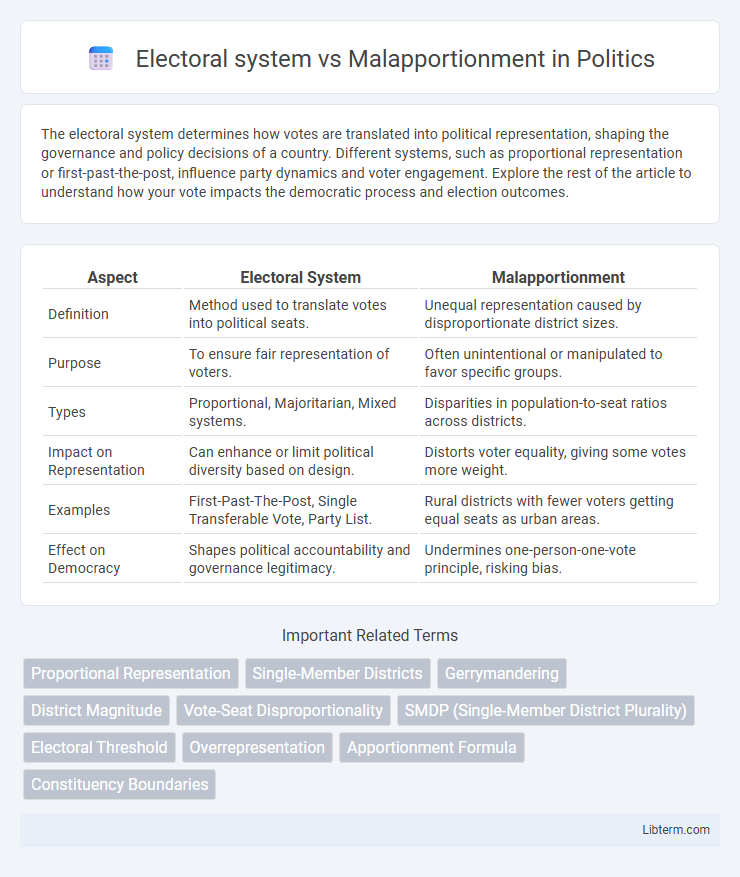The electoral system determines how votes are translated into political representation, shaping the governance and policy decisions of a country. Different systems, such as proportional representation or first-past-the-post, influence party dynamics and voter engagement. Explore the rest of the article to understand how your vote impacts the democratic process and election outcomes.
Table of Comparison
| Aspect | Electoral System | Malapportionment |
|---|---|---|
| Definition | Method used to translate votes into political seats. | Unequal representation caused by disproportionate district sizes. |
| Purpose | To ensure fair representation of voters. | Often unintentional or manipulated to favor specific groups. |
| Types | Proportional, Majoritarian, Mixed systems. | Disparities in population-to-seat ratios across districts. |
| Impact on Representation | Can enhance or limit political diversity based on design. | Distorts voter equality, giving some votes more weight. |
| Examples | First-Past-The-Post, Single Transferable Vote, Party List. | Rural districts with fewer voters getting equal seats as urban areas. |
| Effect on Democracy | Shapes political accountability and governance legitimacy. | Undermines one-person-one-vote principle, risking bias. |
Understanding Electoral Systems: An Overview
Electoral systems define the rules for converting votes into political representation, crucially influencing malapportionment when district populations vary significantly. Malapportionment occurs when electoral districts have unequal representation due to disparities in voter distribution, undermining the principle of "one person, one vote." Proportional representation and single-member district systems impact malapportionment differently, affecting electoral fairness and legislative balance.
Defining Malapportionment in Modern Democracies
Malapportionment in modern democracies occurs when electoral districts are unevenly populated, causing significant disparities in voter representation and undermining the principle of one person, one vote. This imbalance distorts the fairness of electoral systems by granting disproportionate influence to voters in smaller or less populated districts. Addressing malapportionment is critical for maintaining equal representation and ensuring the legitimacy of democratic outcomes.
Types of Electoral Systems and Their Impacts
Major types of electoral systems include plurality/majoritarian, proportional representation, and mixed systems, each influencing representation and party dynamics differently. Plurality systems often lead to disproportional outcomes and favor larger parties, exacerbating malapportionment by amplifying vote-value disparities between districts. Proportional representation mitigates malapportionment by ensuring seats more closely reflect overall vote shares, promoting equitable voter influence across regions.
How Malapportionment Distorts Representation
Malapportionment distorts representation by creating electoral districts with significantly unequal populations, causing votes in less populated areas to carry more weight than those in densely populated districts. This imbalance undermines the principle of "one person, one vote," skewing legislative outcomes and diminishing the political influence of voters in overpopulated constituencies. Electoral systems that fail to address malapportionment risk producing governments that do not accurately reflect the electorate's preferences or demographic distribution.
Comparative Analysis: Proportional vs. Majoritarian Systems
Proportional electoral systems allocate seats based on the percentage of votes each party receives, minimizing malapportionment by ensuring more equitable voter representation across districts. Majoritarian systems, such as first-past-the-post, often exacerbate malapportionment by overrepresenting votes from less populous districts and underrepresenting those from denser urban areas. Comparative analysis reveals that proportional systems enhance democratic fairness and reflect diverse political preferences more accurately than majoritarian frameworks, which tend to concentrate power and skew legislative outcomes.
Case Studies: Malapportionment Across Countries
Malapportionment undermines electoral systems by creating unequal representation, evident in case studies from countries like the United States, where rural districts have disproportionate legislative power despite smaller populations, and Japan, where courts have ruled significant vote weight disparities unconstitutional. In Australia, malapportionment inflates regional votes in favor of rural interests, affecting the balance in parliamentary seats and skewing policy outcomes. These examples highlight how different electoral systems respond to malapportionment, influencing democratic fairness and political equity globally.
Consequences of Malapportionment on Electoral Fairness
Malapportionment distorts electoral fairness by allocating unequal voter representation across districts, undermining the principle of "one person, one vote." This imbalance often leads to overrepresentation of rural or less-populated areas, skewing policy outcomes and weakening the political influence of densely populated urban regions. Such disparities erode democratic legitimacy and can perpetuate entrenched power structures, diminishing overall electoral competitiveness and accountability.
Reforming Electoral Systems to Reduce Malapportionment
Reforming electoral systems to reduce malapportionment involves redesigning district boundaries and implementing proportional representation to ensure voter equality. Weighted voting systems and independent redistricting commissions play a critical role in minimizing disparities in population-to-representative ratios. Empirical evidence shows that countries adopting these reforms experience enhanced democratic legitimacy and fairer political representation.
Legal and Political Challenges in Addressing Malapportionment
Electoral systems often face significant legal and political challenges in addressing malapportionment, where unequal representation distorts democratic fairness. Courts globally encounter complex questions about the constitutionality of malapportioned districts, balancing principles of "one person, one vote" against political realities. Political resistance from entrenched interests further complicates reforms, as malapportionment can benefit certain parties or regions, undermining effective redistricting efforts.
Future Directions: Enhancing Democratic Equality
Future directions in addressing malapportionment focus on designing electoral systems that ensure fair representation by aligning district populations more closely with voter distribution. Implementing independent boundary commissions and adopting proportional representation models can reduce disparities in vote weight and promote democratic equality. Advances in geospatial data analysis and public participation tools also support transparent redistricting processes that uphold electoral fairness.
Electoral system Infographic

 libterm.com
libterm.com